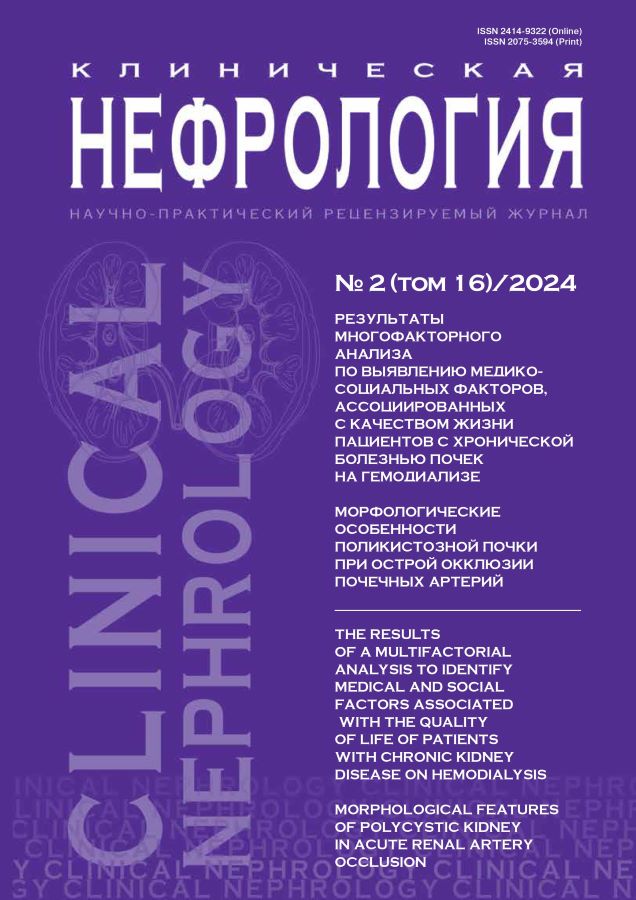Difficulties in diagnosis and treatment of atypical hemolytic-uremic syndrome: clinical case
- 作者: Bakhareva Y.S.1, Chapaeva N.N.2
-
隶属关系:
- Research Institute of Therapy and Preventive Medicine – Branch Campus of the Federal Research Center Institute of Cytology and Genetics of the Siberian Branch of the Russian Academy of Sciences
- Novosibirsk State Medical University of the Ministry of Health of the Russian Federation
- 期: 卷 16, 编号 2 (2024)
- 页面: 58-60
- 栏目: Clinical case
- URL: https://journals.eco-vector.com/2075-3594/article/view/634554
- DOI: https://doi.org/10.18565/nephrology.2024.2.58-60
- ID: 634554
如何引用文章
详细
Background. Atypical hemolytic uremic syndrome (aHUS) is a disease with uncontrolled activation of the alternative complement pathway leading to the development of complement-mediated thrombotic microangiopathy (TMA). A typical triad of aHUS includes acute kidney injury (AKI), nonimmune hemolytic anemia, and consumptive thrombocytopenia.
Objective. Demonstration of the difficulties of diagnosing and treating aHUS.
Clinical case. Patient D., 19 years old, AKI sharply developed after a viral infection. Symptoms characteristic of aHUS included anemia, thrombocytopenia and AKI. Discussion of the diagnosis of TMA within the framework of aHUS became possible due to the results of the patient’s examination for ADAMTS-13, complete restoration of renal function during plasma therapy.
Conclusion. It is extremely important for doctors to be aware of the possibilities of timely diagnosis of aHUS; adequate pathogenetic therapy provides complete restoration of the function of the affected organs.
全文:
作者简介
Yulia Bakhareva
Research Institute of Therapy and Preventive Medicine – Branch Campus of the Federal Research Center Institute of Cytology and Genetics of the Siberian Branch of the Russian Academy of Sciences
编辑信件的主要联系方式.
Email: 8578511@inbox.ru
ORCID iD: 0000-0003-0480-1510
Junior Researcher, Laboratory of Clinical, Population and Preventive Research of Therapeutic and Endocrine Diseases
俄罗斯联邦, NovosibirskNatalya Chapaeva
Novosibirsk State Medical University of the Ministry of Health of the Russian Federation
Email: n.chapaeva@mail.ru
ORCID iD: 0000-0003-0907-5044
Dr.Sci. (Med.), Professor at the Department of Hospital Therapy
俄罗斯联邦, Novosibirsk参考
- Talarico V., Aloe M., Monzani A., et al. Hemolytic uremic syndrome in children. Minerva Pediatr. 2016;68(6): 441–55.
- Crawford B., Strebeck P., Saccente S. Constipation and hemolytic uremic syndrome. Pediatr. Nephrol. 2024;39(2):603–07. doi: 10.1007/s00467-023-06093-8.
- Viteri B., Saland J.M. Hemolytic Uremic Syndrome. Pediatr. Rev. 2020;41(4):213–15. doi: 10.1542/pir.2018-0346.
- Yerigeri K., Kadatane S., Mongan K., et al. Atypical Hemolytic-Uremic Syndrome: Genetic Basis, Clinical Manifestations, and a Multidisciplinary Approach to Management. J. Multidiscip. Healthc. 2023;16:2233–49. doi: 10.2147/JMDH.S245620.
- Leon J., LeStang M.B., Sberro-Soussan R., et al. Complement-driven hemolytic uremic syndrome. Am. J. Hematol. 2023;98(4): 44–56. doi: 10.1002/ajh.26854.
- Spasiano A., Palazzetti D., Dimartino L., et al. Underlying Genetics of aHUS: Which Connection with Outcome and Treatment Discontinuation? Int. J. Mol. Sci. 2023;24(19):14496. doi: 10.3390/ijms241914496.
- Fakhouri F., Schwotzer N., Frémeaux-Bacchi V. How I diagnose and treat atypical hemolytic uremic syndrome. Blood. 2023;141(9): 984–95. doi: 10.1182/blood.2022017860.
补充文件







